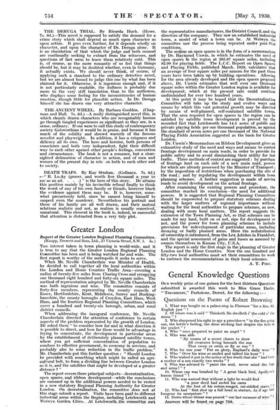Greater London
Report of the Greater London Regional Planning Committee. (Knapp, Drewett and Sons, Ltd., 3) Victoria Street, S.W. 1. 5s. ) THE interest taken in town planning is world-wide, and it is true to say that the Greater London Regional Planning Committee has been and is being watched far and wide. The first report is worthy of the metropolis it seeks to serve.
When Mr. Neville Chamberlain was Minister of Health, he decided to call together all the local authorities within the London and Home Counties Traffic Area—covering a radius of twenty-five miles from Charing Cross and occupying one thousand eight hundred and forty-six square miles. The method of representation adopted by Mr. Neville Chamberlain was both ingenious and wise. The committee consists of forty-five members, representing the county wand's of Essex, Hertfordshire, Kent, Middlesex, Surrey and -Bucking- hamshire, the county boroughs of Croydon, East Ham, West Ham, and the fourteen Regional Planning Committees, which cover a hundred and twenty-six borough, urban, and rural district councils.
When addressing the inaugural conference, Mr. Neville Chamberlain directed the attention of conference to certain aspects of the problem represented by the growth of London. He asked them "to consider how far and in what direction it is possible to direct, and how far there would be advantage in trying to concentrate, the development in particular areas • by the establishment of deliberately planned satellite towns, 'where you get sufficient concentration of population to conduce to effective government, to economy in services, and probably also to some reduction in the traffic problem." Mr. Chamberlain put this further question : "Should London be provided with something which might be called an agri- cultural belt, to form a dividing line between Greater London as it is, and the satellites that might be developed at a greater distance?"
The report covers three principal subjects—decentralization, open spaces, an„d ribbon development—while the conclusions are summed up in the additional powers needed to be vested in a new statutory Regional Planning Authority for Greater London. On decentralization, the committee does not at this stage submit a report. Visits have bee° paid to different • industrial areas within the Region, including Letchworth and 'Welwyn Garden Cities. ,At Letchworth_the comnaittite met
the representative manufacturers, the District Council, and the directors of the company. They saw- an established industrial town, a model of what a town can be. At Welwyn the committee saw the process being repeated under post-War condition*.
The seclion on open spaces is in the form of a memorandum by Dr. Rayinond Unwin, in which he estimates the need of open spaces in the region at 205.87 square miles, including 82.99 for playing fields. The L.C.C. Report on Open Spaces and Playing Fields, published March, 1929, 'calculates that an average of four sqnare miles per annum for the past three years have been taken tip by building operations. Allowing for the area already developed and the open spaces proposed above, Dr. Unwin estimates that well over one thousand square miles within the Greater London region is available for development, which at the present rate could continue undiminished for over two hundred years.
At this point it May be hoped that the Decentralization .Committee will take up the study and evolve ways and means by which this vast potential growth may be directed -by means of well-planned, self-contained satellite towns, That the area required for open spaces in the region can be satisfied by satellite town development is proved by the recorded fact that Letchworth has 14.5 acres of public and private playing fields per one thousand population, as against
• the standard of seven acres per one thousand of the National Playing Fields Association suggested as the basis for Greater. . London.
Dr. Unwin's Memorandum on Ribbon Development gives an • exhaustive study of the need and ways and means to control -frontage development on main roads, in order to provide for .public safety and to avoid diminishing their utility for fast traffic. Three methods of control are suggested : by purchase of frontage land on each side of a new main road, powers for which are already possessed by the Minister of Transport ; by the imposition of restrictions when purchasing the site of the road; and by regulating the deVelOpinefit within town planning schemes. A further suggestion is made of service roads to avoid development on the actual frontage.
After examining the existing powers and procedure, the committee reached its conclusion—the need for additional powers. It is suggested that Regional Planning Committees should be empowered to prepare statutory schemes dealing' with the larger matters of regional importance without waiting, for the local authorities to prepare schemes, as now, dealing with more local matters.The report suggests the extension of the Town Planning Act, 'so that schemes can be made for any land, built on or not, ripe for development or not, and the power for town planning schemes to include provisions for redevelopment of particular areas, including decaying or badly' planned areas. Here the redistribution of ownership is introduced, front the Lox Adickes in Frankfort, and the special assessment of _gains and losses as assessed by owners themselves in Kansas City, U.S.A. The report is only the first stage in the 'planning of Greater London and the Home Counties. Now the one hundred and fifty-two local Authorities must set their committees to work to embrace the recommendations in their local schemes. - A. T. PIKE.














































 Previous page
Previous page